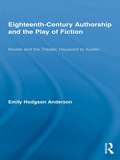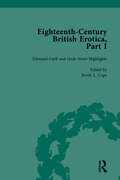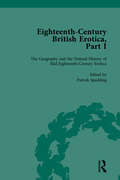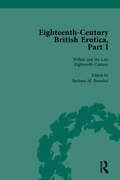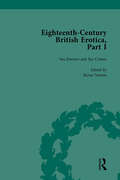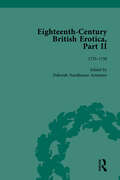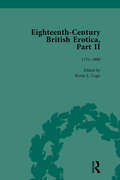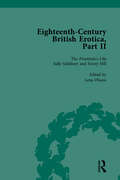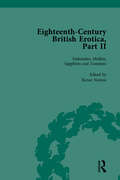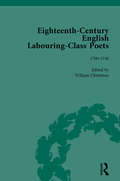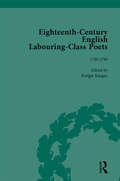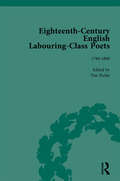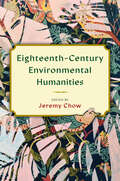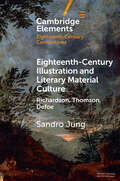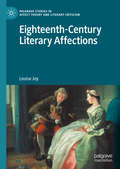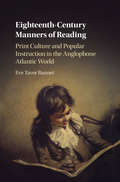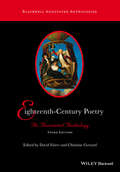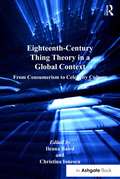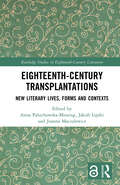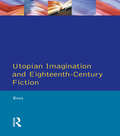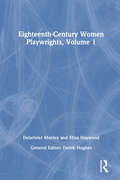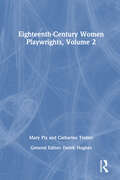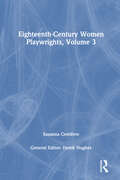- Table View
- List View
Eighteenth-Century Authorship and the Play of Fiction: Novels and the Theater, Haywood to Austen (Routledge Studies in Eighteenth-Century Literature)
by Emily Hodgson AndersonThis study looks at developments in eighteenth-century drama that influenced the rise of the novel; it begins by asking why women writers of this period experimented so frequently with both novels and plays. Here, Eliza Haywood, Frances Burney, Elizabeth Inchbald, Maria Edgeworth, and Jane Austen explore theatrical frames--from the playhouse, to the social conventions of masquerade, to the fictional frame of the novel itself—that encourage audiences to dismiss what they contain as feigned. Yet such frames also, as a result, create a safe space for self-expression. These authors explore such payoffs both within their work—through descriptions of heroines who disguise themselves to express themselves—and through it. Reading the act of authorship as itself a form of performance, Anderson contextualizes the convention of fictionality that accompanied the development of the novel; she notes that as the novel, like the theater of the earlier eighteenth century, came to highlight its fabricated nature, authors could use it as a covert yet cathartic space. Fiction for these authors, like theatrical performance for the actor, thus functions as an act of both disclosure and disguise—or finally presents self-expression as the ability to oscillate between the two, in "the play of fiction."
Eighteenth-Century British Erotica, Part I vol 2
by Kevin L. CopeThis set reprints many of the 18th century's most notorious works, including eight from "The Fifteen Plagues of a Maiden-Head" (1707), that resulted in highly publicized court battles and in some cases helped shape laws on censorship that survived into modernity.
Eighteenth-Century British Erotica, Part I vol 3
by Patrick SpeddingThis set reprints many of the 18th century's most notorious works, including eight from "The Fifteen Plagues of a Maiden-Head" (1707), that resulted in highly publicized court battles and in some cases helped shape laws on censorship that survived into modernity.
Eighteenth-Century British Erotica, Part I vol 4
by Barbara M. BenedictThis set reprints many of the 18th century's most notorious works, including eight from "The Fifteen Plagues of a Maiden-Head" (1707), that resulted in highly publicized court battles and in some cases helped shape laws on censorship that survived into modernity.
Eighteenth-Century British Erotica, Part I vol 5
by Rictor NortonThis set reprints many of the 18th century's most notorious works, including eight from "The Fifteen Plagues of a Maiden-Head" (1707), that resulted in highly publicized court battles and in some cases helped shape laws on censorship that survived into modernity.
Eighteenth-Century British Erotica, Part II vol 1
by Janine BarchasComprises a variety of topics, from prostitution to flatulence, and paints a picture of the real and imaginative worlds inhabited by the people of eighteenth-century Britain. This title features a volume dedicated to homosexuality. It is intended for students of eighteenth century culture, queer theory, history of sexuality and book history.
Eighteenth-Century British Erotica, Part II vol 2
by Deborah Needleman ArmintorComprises a variety of topics, from prostitution to flatulence, and paints a picture of the real and imaginative worlds inhabited by the people of eighteenth-century Britain. This title features a volume dedicated to homosexuality. It is intended for students of eighteenth century culture, queer theory, history of sexuality and book history.
Eighteenth-Century British Erotica, Part II vol 3
by Kevin L. CopeComprises a variety of topics, from prostitution to flatulence, and paints a picture of the real and imaginative worlds inhabited by the people of eighteenth-century Britain. This title features a volume dedicated to homosexuality. It is intended for students of eighteenth century culture, queer theory, history of sexuality and book history.
Eighteenth-Century British Erotica, Part II vol 4
by Lena OlssonComprises a variety of topics, from prostitution to flatulence, and paints a picture of the real and imaginative worlds inhabited by the people of eighteenth-century Britain. This title features a volume dedicated to homosexuality. It is intended for students of eighteenth century culture, queer theory, history of sexuality and book history.
Eighteenth-Century British Erotica, Part II vol 5
by Rictor NortonComprises a variety of topics, from prostitution to flatulence, and paints a picture of the real and imaginative worlds inhabited by the people of eighteenth-century Britain. This title features a volume dedicated to homosexuality. It is intended for students of eighteenth century culture, queer theory, history of sexuality and book history.
Eighteenth-Century English
by Raymond HickeyThe eighteenth century was a key period in the development of the English language, in which the modern standard emerged and many dictionaries and grammars first appeared. This book is divided into thematic sections which deal with issues central to English in the eighteenth century. These include linguistic ideology and the grammatical tradition, the contribution of women to the writing of grammars, the interactions of writers at this time and how politeness was encoded in language, including that on a regional level. The contributions also discuss how language was seen and discussed in public and how grammarians, lexicographers, journalists, pamphleteers and publishers judged on-going change. The novel insights offered in this book extend our knowledge of the English language at the onset of the modern period.
Eighteenth-Century English Labouring-Class Poets, vol 1
by John Goodridge Simon Kövesi David Fairer Tim Burke William ChristmasPoets of labouring class origin were published in Britain in the 18th and 19th centuries. Some were popular and important in their day but few are available today. This is a collection of some of those poems from the 18th century.
Eighteenth-Century English Labouring-Class Poets, vol 2
by John Goodridge Simon Kövesi David Fairer Tim Burke William ChristmasPoets of labouring class origin were published in Britain in the 18th and 19th centuries. Some were popular and important in their day but few are available today. This is a collection of some of those poems from the 18th century.
Eighteenth-Century English Labouring-Class Poets, vol 3
by John Goodridge Simon Kövesi David Fairer Tim Burke William ChristmasPoets of labouring class origin were published in Britain in the 18th and 19th centuries. Some were popular and important in their day but few are available today. This is a collection of some of those poems from the 18th century.
Eighteenth-Century Environmental Humanities (Transits: Literature, Thought & Culture, 1650-1850)
by Shelby Johnson Jeremy Chow Elliot Patsoura Annette Hulbert Adam Sweeting Mariah Crilley Claire Campbell Jason Payton Matt Duquès Ami Yoon Christopher Allan Black Kate ScarthThis groundbreaking new volume unites eighteenth-century studies and the environmental humanities, showcasing how these fields can vibrantly benefit one another. In eleven chapters that engage a variety of eighteenth-century texts, contributors explore timely themes and topics such as climate change, new materialisms, the blue humanities, indigeneity and decoloniality, and green utopianism. Additionally, each chapter reflects on pedagogical concerns, asking: How do we teach eighteenth-century environmental humanities? With particular attention to the voices of early-career scholars who bring cutting-edge perspectives, these essays highlight vital and innovative trends that can enrich both disciplines, making them essential for classroom use.
Eighteenth-Century Illustration and Literary Material Culture: Richardson, Thomson, Defoe (Elements in Eighteenth-Century Connections)
by Sandro JungThis Element studies eighteenth- and early nineteenth-century instances of transmediation, concentrating on how the same illustrations were adapted for new media and how they generated novel media constellations and meanings for these images. Focusing on the 'content' of the illustrations and its adaptation within the framework of a new medium, case studies examine the use across different media of illustrations (comprehending both the designs for book illustrations and furniture prints) of three eighteenth-century works: Defoe's Robinson Crusoe (1719), Thomson's The Seasons (1730) and Richardson's Pamela (1740). These case studies reveal how visually enhanced material culture not only makes present the literary work, including its characters and story-world. But they also demonstrate how, through processes of transmediation, changes are introduced to the illustration that affect comprehension of that work. This title is also available as Open Access on Cambridge Core.
Eighteenth-Century Literary Affections (Palgrave Studies in Affect Theory and Literary Criticism)
by Louise JoyThis book assesses the mediating role played by 'affections' in eighteenth-century contestations about reason and passion, questioning their availability and desirability outside textual form. It examines the formulation and idealization of this affective category in works by Isaac Watts, Lord Shaftesbury, Mary Hays, William Godwin, Helen Maria Williams, and William Wordsworth. Part I outlines how affections are invested with utopian potential in theology, moral philosophy, and criticism, re-imagining what it might mean to know emotion. Part II considers attempts of writers at the end of the period to draw affections into literature as a means of negotiating a middle way between realism and idealism, expressivism and didacticism, particularity and abstraction, subjectivity and objectivity, femininity and masculinity, radicalism and conservatism, and the foreign and the domestic.
Eighteenth-Century Manners of Reading: Print Culture and Popular Instruction in the Anglophone Atlantic World
by Eve Tavor BannetThe market for print steadily expanded throughout the eighteenth-century Atlantic world thanks to printers' efforts to ensure that ordinary people knew how to read and use printed matter. Reading is and was a collection of practices, performed in diverse, but always very specific ways. These practices were spread down the social hierarchy through printed guides. Eve Tavor Bannet explores guides to six manners or methods of reading, each with its own social, economic, commercial, intellectual and pedagogical functions, and each promoting a variety of fragmentary and discontinuous reading practices. The increasingly widespread production of periodicals, pamphlets, prefaces, conduct books, conversation-pieces and fictions, together with schoolbooks designed for adults and children, disseminated all that people of all ages and ranks might need or wish to know about reading, and prepared them for new jobs and roles both in Britain and America.
Eighteenth-Century Poetry: An Annotated Anthology (Blackwell Annotated Anthologies #35)
by Christine Gerrard David FairerCurrently the definitive text in the field and now available in an expanded third edition, Eighteenth-Century Poetry presents the rich diversity of English poetry from 1700-1800 in authoritative texts and with full scholarly annotation. Balanced to reflect current interests and “favorites” (including prominent poets like Finch, Swift, Pope, Montagu, Johnson, Gray, Burns, and Cowper) as well as less familiar material, offering a variety of voices and new directions for research and learning Includes 46 new poems with more texts by women poets and the inclusion of four additional poets (Mary Barber, Mehetabel Wright, Anna Seward, and Mary Robinson); poems reflecting new ecological approaches to 18th-century literature; and poems on the art of writing Accessible and user-friendly, with generous head notes, full foot-of-page annotations, an expanded thematic index, and a visually appealing text design
Eighteenth-Century Thing Theory in a Global Context: From Consumerism to Celebrity Culture
by Ileana Baird Christina IonescuExploring Enlightenment attitudes toward things and their relation to human subjects, this collection offers a geographically wide-ranging perspective on what the eighteenth century looked like beyond British or British-colonial borders. To highlight trends, fashions, and cultural imports of truly global significance, the contributors draw their case studies from Western Europe, Russia, Africa, Latin America, and Oceania. This survey underscores the multifarious ways in which new theoretical approaches, such as thing theory or material and visual culture studies, revise our understanding of the people and objects that inhabit the phenomenological spaces of the eighteenth century. Rather than focusing on a particular geographical area, or on the global as a juxtaposition of regions with a distinctive cultural footprint, this collection draws attention to the unforeseen relational maps drawn by things in their global peregrinations, celebrating the logic of serendipity that transforms the object into some-thing else when it is placed in a new locale.
Eighteenth-Century Transplantations: New Literary Lives, Forms and Contexts (Routledge Studies in Eighteenth-Century Literature)
by Jakub Lipski Joanna Maciulewicz Anna Paluchowska-MessingThis collection studies eighteenth-century British literature as enmeshed within a dynamic intercultural traffic, participating in the import and export of literary and cultural forms. Eighteenth-Century Transplantations places this transcultural circulation at the centre of attention and presents its products in a unique configuration. Literary transplants into the British context, out of it, and their transmedial afterlives are set together in order to showcase the mechanisms of such cultural commerce. The term 'transplantation', borrowed from medical and horticultural discourses and evocative of eighteenth-century experiments in gardening, is offered here as a useful kinetic model to conceptualize the diverse practices involved in relocating a literary text into a new cultural environment.
Eighteenth-Century Utopian Fiction (Studies In Eighteenth and Nineteenth Century Literature Series)
by Christine ReesUtopian fiction was a particularly rich and important genre during the eighteenth century. It was during this period that a relatively new phenomenon appeared: the merging of utopian writing per se with other fictional genres, such as the increasingly dominant novel. However, while early modern and nineteenth and twentieth century utopias have been the focus of much attention, the eighteenth century has largely been neglected. Utopian Imagination and Eighteenth Century Fiction combines these major areas of interest, interpreting some of the most fascinating and innovative fictions of the period and locating them in a continuing tradition of utopian writing which stretches back through the Renaissance to the Ancient World.Begining with a survey of the recurrent topics in utopian writing - power structures in the state, money, food, sex, the role of women, birth, education and death - the book brings together canonical eighteenth century texts countaining powerful utopian elements, such as Robinson Crusoe, Gulliver's Travels and Rasselas, and less familiar works, to examine the reworking of these topics in a new context. The unfamiliar texts, including Gaudentio di Lucca, are described in detail to give students an idea of relevant material across a broad area. A section is devoted specifically to women writes, an area which has become the focus of attention. The mixture of texts provides a useful cross-reference for students tackling the subject from various perspectives and the comprehensive bibliography provides a valuable tool for those with general or specific interests
Eighteenth-Century Women Playwrights, vol 1
by Derek HughesThis six-volume anthology documents the history of women's drama throughout the 18th century, starting with the emergence in 1695-6 of the second generation of women dramatists to Aphra Benn. It includes the work of Catherine Trotter, Mary Pix, Eliza Haywood and Elizabeth Griffith.
Eighteenth-Century Women Playwrights, vol 2
by Derek HughesThis six-volume anthology documents the history of women's drama throughout the 18th century, starting with the emergence in 1695-6 of the second generation of women dramatists to Aphra Benn. It includes the work of Catherine Trotter, Mary Pix, Eliza Haywood and Elizabeth Griffith.
Eighteenth-Century Women Playwrights, vol 3
by Derek HughesThis six-volume anthology documents the history of women's drama throughout the 18th century, starting with the emergence in 1695-6 of the second generation of women dramatists to Aphra Benn. It includes the work of Catherine Trotter, Mary Pix, Eliza Haywood and Elizabeth Griffith.
